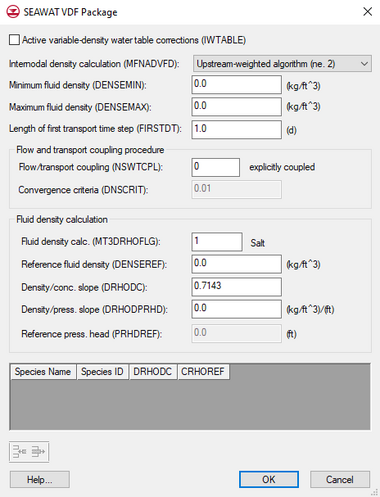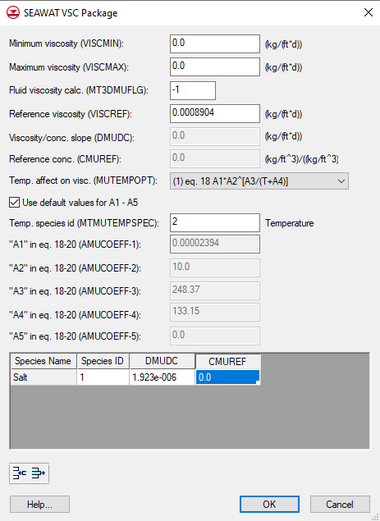GMS:SEAWAT Packages: Difference between revisions
| Line 44: | Line 44: | ||
* (3) equation 20 <math>A_1*T^{A_2}</math> | * (3) equation 20 <math>A_1*T^{A_2}</math> | ||
</blockquote> | </blockquote> | ||
* | * ''Use default values for A1–A5'' – When on, disables edit fields for AMUCOEFF as the default values will be used. | ||
* ''Temperature species ID (MTMUTEMPSPEC)'' – The MT3DMS species number that corresponds to temperature. | |||
* AMUCOEFF – Coefficients for equation 18-20 in SEAWAT 4 documentation. | * ''AMUCOEFF'' – Coefficients for equation 18-20 in SEAWAT 4 documentation. | ||
===Species Table=== | ===Species Table=== | ||
Revision as of 17:19, 14 July 2016
SEAWAT specific packages include the Variable-Density Flow (VDF) and Viscosity (VSC) packages. The package dialogs for both packages are available under the SEAWAT menu. For the package menu items to be available, the packages must first be enabled from the SEAWAT Global Options Dialog. For a detailed description of the VDF and VSC input options, please refer to the SEAWAT manual.
VDF Package
The VDF package can be used in a SEAWAT simulation to model the affects of concentration on fluid density. The input values available in the VDF package include:
- Active variable-density water table corrections (IWTABLE) – A flag used to activate the variable-density water-table corrections when turned on.
- Internodal density calculation method (MFNADVFD) – A flag that determines the method for calculating the internodal density values used to conserve fluid mass. Options include:
- Central-in-space algorithm (eq. 2)
- Upstream-weighted algorithm (ne. 2)
- Minimum fluid density (DENSEMIN) – If the resulting density value calculated with the equation of state is less than this value, the density value is set to the entered value.
- Maximum fluid density (DENSEMAX) – If the resulting density value calculated with the equation of state is greater than this value, the density value is set to the entered value.
- Length of first transport time step (FIRSTDT) – Used to start the simulation if both the IMT Process is active and transport time steps are calculated as a function of the user-specified Courant number.
- Flow/transport coupling (NSWTCPL) – A flag used to determine the flow and transport coupling procedure. If 0 or 1, flow and transport will be explicitly coupled using a one-timestep lag. If greater than 1 then will be the maximum number of non-linear coupling iterations for the flow and transport solutions. If -1 the flow solution will be recalculated for the first transport step of the simulation, or the last transport step of the MODFLOW time step, or the maximum density change at a cell is greater than DNSCRIT.
- Convergence criteria (DNSCRIT) – . Value for the maximum change in fluid density.
- Fluid density calculation (MT3DRHOFLG) – The MT3DMS species number that will be used in the equation of state to compute fluid density. When equal to zero, the fluid density for each grid cell can be entered in the table at the bottom of the dialog. For INDENSE enter -1 to use values from previous stress period, 0 to use DENSREF, and 1 to enter values for DENSE column. When equal to -1, the fluid density will be calculated using one or more species entered in the table at the bottom of the dialog using species ID, DRHODC, and CRHOREF. Rows can be entered into the table with the tool bar below the table. When greater than or equal to 1 density is calculated using the corresponding species number.
- Reference fluid density (DENSEREF) – The fluid density at the reference concentration, temperature, and pressure.
- Density/concentration slope (DRHODC) – The slope of the linear equation of state that relates fluid density to solute concentration.
- Density/pressure slope (DRHODPRHD) – The slope of the linear equation of state that relates fluid density to the height of the pressure head.
- Reference pressure head (PRHDREF) – The reference pressure head. This value should normally be set to zero.
Species Table
This table allows adding or removing each solute species by using the Insert Row File:GMS - Insert Row icon.png or Delete Row File:GMS - Delete Row icon.png buttons. Options for the VDF package include:
- Species Name – The name will be based on the assigned Species ID.
- Species ID – The identity number of the species as assinged in the MT3D model.
- DRHODC – Density/concentration slope.
- CRHOREF – The reference concentration for species.
VSC Package
The VSC package can be used in a SEAWAT simulation to model the affects of concentration on fluid viscosity. Using the Viscosity Package requires using the VDF package and the LPF package in MODFLOW. The input values available in the VSC package include:
- Minimum viscosity (VISCMIN) – If the resulting viscosity value calculated with the equation is less than this value, the viscosity value is set to the entered value.
- Maximum viscosity (VISCMAX) – If the resulting viscosity value calculated with the equation is greater than this value, the viscosity value is set to the entered value.
- Fluid viscosity calculation (MT3DMUFLG) – When equal to zero, the fluid viscosity for each grid cell can be entered in the table at the bottom of the dialog. For INVISC enter -1 to use values from previous stress period, 0 to use VISCREF, and 1 to enter values for VISC column. When equal to -1, the fluid density will be calculated using one or more species entered in the table at the bottom of the dialog using species ID, DMUDC, and CMUREF. Rows can be entered into the table with the tools bar below the table. When greater than or equal to 1 viscosity is calculated using the corresponding species number.
- Reference viscosity (VISCREF) – The fluid viscosity at the reference concentration and reference temperature.
- Viscosity/concentration slope (DMUDC) – The slope of the linear equation that relates fluid viscosity to solute concentration.
- Reference concentration (CMUREF) – The reference concentration for species.
- Temperature effect on viscocity (MUTEMPOPT) – A flag that specifies the option for including the effect of temperature on fluid viscosity. It has the following options:
- (0) No temperature effect or linear relation
- (1) equation 18
- (2) equation 19
- (3) equation 20
- Use default values for A1–A5 – When on, disables edit fields for AMUCOEFF as the default values will be used.
- Temperature species ID (MTMUTEMPSPEC) – The MT3DMS species number that corresponds to temperature.
- AMUCOEFF – Coefficients for equation 18-20 in SEAWAT 4 documentation.
Species Table
This table allows adding or removing each solute species by using the Insert Row File:GMS - Insert Row icon.png or Delete Row File:GMS - Delete Row icon.png buttons. Options for the VSC package include:
- Species Name – The name will be based on the assigned Species ID.
- Species ID – The identity number of the species as assinged in the MT3D model.
- DMUDC – Viscosity/concentration slope.
- CMUREF – Reference concentration.
GMS – Groundwater Modeling System | ||
|---|---|---|
| Modules: | 2D Grid • 2D Mesh • 2D Scatter Point • 3D Grid • 3D Mesh • 3D Scatter Point • Boreholes • GIS • Map • Solid • TINs • UGrids | |
| Models: | FEFLOW • FEMWATER • HydroGeoSphere • MODAEM • MODFLOW • MODPATH • mod-PATH3DU • MT3DMS • MT3D-USGS • PEST • PHT3D • RT3D • SEAM3D • SEAWAT • SEEP2D • T-PROGS • ZONEBUDGET | |
| Aquaveo | ||



![{\displaystyle A_{1}*[A_{2}+A_{3}(T+A_{4})]_{5}^{A}}](https://en.wikipedia.org/api/rest_v1/media/math/render/svg/220501425d16a7a3bbe2dcb2055fea0eb8d374a5)
